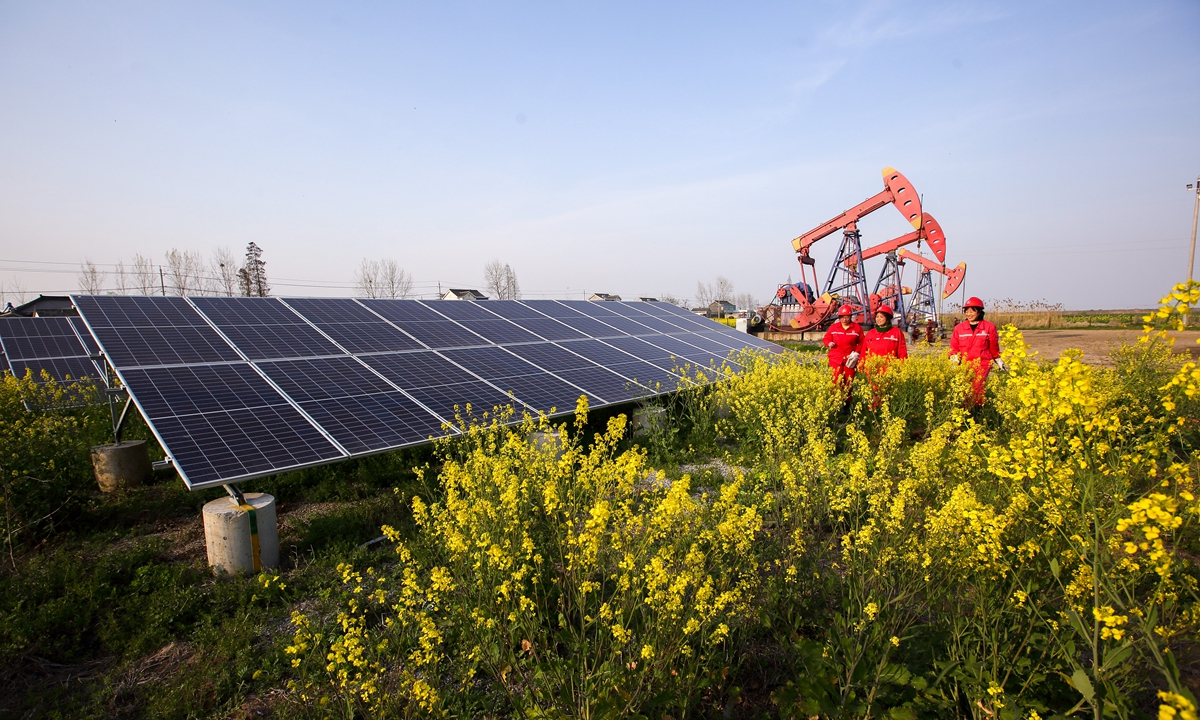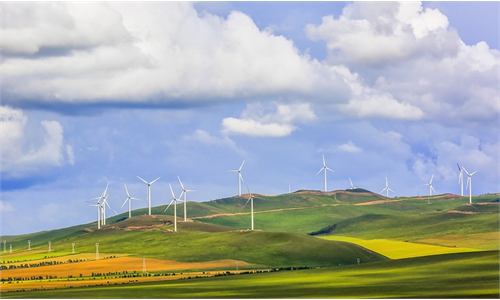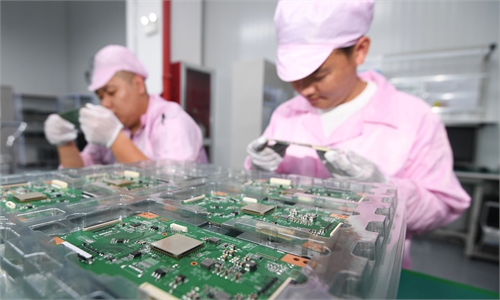
Solar panels generate power at an oil field in East China's Jiangsu Province. Photo: cnsphoto
China's pledge to be carbon neutral by 2060, a mission with a tight schedule for a country still being industrialized, suggests tremendous restructuring and funding efforts over the coming decades to carve out an China-specific approach to green growth, industry insiders said at a just-concluded major services trade fair in Beijing where a clearer path to the would-be central pillar of economic growth was mapped out.
Ambitious goal, tight schedule
The US' annual carbon dioxide emissions stand at 4.8 billion tons and the emissions in the case of the US, Europe and Japan all spiral downward. As a developing country, China is confronted with a double mission ahead to achieve carbon neutrality just 30 years after reaching peak emissions, while the time phrase is closer to 40-50 years in developed nations, Li Yizhong, former minister of industry and information technology, said Monday in address to a forum during the China International Fair for Trade in Services (CIFTIS).
Carbon dioxide emissions resulting from China's production and consumption hit 10 billion tons in 2019, accounting for nearly 30 percent of the world's total. Additionally, China's carbon dioxide emissions are still rising at an annual average growth rate of about 1.5 percent.
The emissions-cutting goals lie at the restructuring of the country's energy, industrial and manufacturing structure, with a focus on non-fossils, according to Li, currently president of China Federation of Industrial Economics.
In the words of Liu Yanhua, director of the National Expert Committee on Climate Change and former vice minister of science and technology, "extremely arduous efforts" will be required for China to hit its carbon peak and neutrality targets.
China is still climbing up the slope along its road map for industrialization, with many industries at the lower-end of supply chains remaining energy-intensive, Liu said, describing the carbon transformation underway as the rebirth of the economy.

Visitors walk across the Shougang Industrial Park in western Beijing, a newly added host venue for this year's China International Fair for Trade in Services, on Sunday. Photo: Li Qiaoyi/GT
China is on a very tight scheduled to hit its dual goals. The path to industrialization took 200 years in developed countries in the West, while China only has roughly 60 years; Western nations need 200 years to hit a carbon dioxide emissions peak, while China is on course to hit this mark by 2030, Liu went on to say, adding that the US is scheduled for 43 years from its emissions peak to neutrality by 2050, compared with 71 years in the EU and merely 30 years in China.
In a fresh move to honor its carbon promises, the National Development and Reform Commission on Tuesday elaborated on the launch of a green power trading trial program across the country, expecting the use of emerging technologies, notably blockchain, to put in place a new electricity system based primarily on new energy.
The annual services event concluded Tuesday, with carbon neutral green technological services sector one of its highlights.
A raft of low carbon technologies, clean energy applications, energy storage technologies, carbon capture and utilization, carbon sink and ecological construction, carbon market services were on display at the tradeshow.
Among the low carbon-focused exhibitors is French energy giant Schneider Electric which launched its carbon neutrality consulting service at the event. The new service ranges from top-level planning to implementation, aiming to help Chinese companies accelerate their carbon neutrality process.
"At present, China is undergoing a critical period of carbon neutrality," Yin Zheng, executive vice president of Schneider Electric and president of Schneider Electric China, said in a statement sent to the Global Times.

A renewable energy base in Sihong County, East China's Jiangsu Province is seen on Sunday as wind turbines spin. The base can generate 650 million kilowatt-hours of power annually, with tax revenue of 50 million yuan ($7.7 million). The annual income of fishery breeding amounts to 45 million yuan, and tourism income to 20 million yuan. A total of 640,000 tons of carbon emissions can be avoided every year. Photo: VCG
Long road ahead
The country's 2060 goal would supposedly necessitate investments totaling 136 trillion yuan ($21.07 trillion), according to industry estimates revealed during the keenly-watched services event.
It would be easy to achieve carbon dioxide emissions peak whereas the goal of reaching carbon neutrality will be difficult, as 60 percent of the technologies underpinning carbon neutrality remains at a conceptual stage, necessitating a massive amount of capital injections and the support of basic research, Zhang Shaogang, vice chairman of the China Council for the Promotion of International Trade, said at a separate forum on carbon neutrality during the CIFTIS.
The country should explore a low carbon path that suits its own development and rely on technological innovation to "build a moat," thereby ensuring the development initiative is "firmly grasped in our [own] hands," Zhang said.
The 136 trillion yuan required for the carbon neutrality push suggests other than government spending, substantial social capital will be needed to have the market play a bigger part in funding the pledge, he disclosed.
A significant step in this regard was the announcement by China Internet Development Foundation at the first China Digital Carbon Neutrality Summit in Chengdu, Southwest China's Sichuan Province on Tuesday that preparatory work kicked off on a digital carbon neutrality special fund.
The foundation, together with more than 100 firms and institutions including Alibaba, Tencent and Baidu, also jointly unveiled an initiative for digital space and green, low-carbon activities at the forum.
The country's carbon trading market was forecast to hit 300 billion-yuan, with many in the field viewing it as a blue ocean with enormous opportunities.
In a sign of progress, Chinese digital mapping and navigation firm AutoNavi inked a deal featuring 15,000 tons of carbon dioxide emissions resulting from green transport with Beijing Municipal Road & Bridge Building Material Group Co on Saturday during the annual services trade fair. The carbon trading deal is the first market-oriented arrangement of its kind globally.
Reputing carbon neutrality as a systematic project "that can be achieved only by cooperation from all parties, Yin said the CIFTIS, an indication of China's long-term commitment in openness and cooperation, offers the company a significant platform for dialogue and exchange.
With the process of China's new development, "service from China" gradually attracts more market opportunities, he commented.
The country's path of carbon neutrality, initially focusing on reduced emissions in the factory sector, is anticipated to gradually shift toward a wider range of industries such as animal husbandry, Zhang Xiaoping, country director for China at the US Soybean Export Council (USSEC), told the Global Times besides the council's stall at the CIFTIS. The USSEC participated in the annual event for the first time as an independent exhibitor.
Livestock farmers will one day become active participants in China's national carbon trading market as the country scales up its carbon dioxide emissions push, Zhang said.



